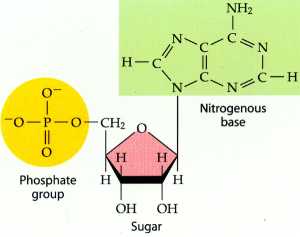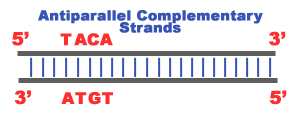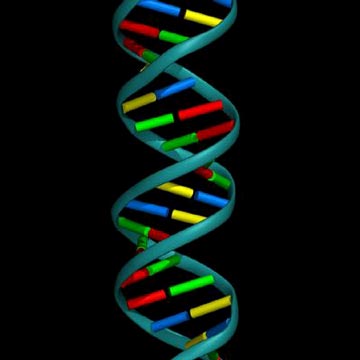DNA Double Helix
Lets have a look in how the DNA Double Helix (two DNA strands) looks like. Every DNA strand is consisted of nucleotides. Nucleotides are monomers that are made of a phosphate, a sugar (deoxyribose) and a heterocyclic base (Thimine, Cytosine -pyrimidines- Adenine, Guanine - purines-). The combination of a sugar and an heterocyclic base gives a nucleoside. When a phosphate is added to the molecule, a nucleotide is created.
The backbone of each strand consists of alternating phosphates and deoxyriboses. To be more specific, the phosphate of a nucleotide bonds both to the 5' carbon of one deoxyribose and the 3' carbon of the next deoxyribose. This is how the nucleotides create the strand. The 5' and 3' refers to the place of the carbons in the deoxyribose molecule. The heterocyclic bases which are attached to the deoxyriboses project in towards the axis of the helix.
The two polynucleotide strands wound around each other. The strands of a DNA double Helix are antiparallel which means that the one chain runs 5'-3' and the other runs 3'- 5'. The connections of the two strands are due to the hydrogen bonds between the nucleotide bases of the two strands. Connections happen between the adenines and thymines (2 hydrogen bonds) and between cytosines and guanines (3 hydrogen bonds). The two strands are complementary, which means that the strand running in the 5'A 3' direction will have base Adenine that will pair with base Thymine on the opposite strand running in 3'A 5' direction. Since the strands are complementary and antiparallel, each of them can be a matrix for the creation of a new complementary and antiparallel strand, as we can see in another chapter of this site.

The DNA Double Helix makes a complete turn in over 10 nucleotide pairs, so each turn takes 35.7 ?. About 25 hydrogen bonds are created in this complete turn. The power of these 25 bonds is equal to 1 covalent bond (bond between carbon and oxygen). The diameter of a DNA Double Helix is 20 ?. The length of the helix can be 2 cm (!!) if the helix is fully stretched.

The hydrogen bonds and the bonds between deoxyribose and phosphates are the main (but not only) chemical forces that create a DNA Double helix (pic.2).
No comments:
Post a Comment